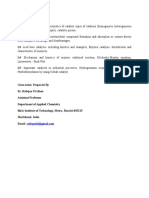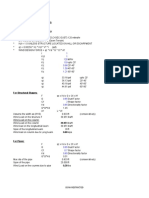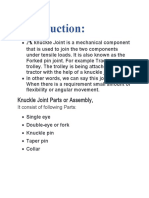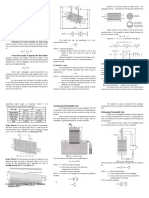Catalyst Chapter-4
Uploaded by
Mohit VamjaCatalyst Chapter-4
Uploaded by
Mohit VamjaChapter Number - 5
Name of Chapter: Catalysis
Catalysts : Catalysis is the increase in rate of reaction by addition of substance called
‘Catalyst’. Catalysts are those substances /material that on addition will alter the path of
reaction by forming temporary intermediate and thus lowering the rate of reaction. There are
two types of catalysts (i) Homogeneous catalyst (ii) Heterogeneous catalyst (i) Homogeneous
catalyst: A homogeneous catalyst is one whose molecules are dispersed in the same phase
(usually gaseous or liquid) as the reactant molecules (ii) Heterogeneous catalysts: A
heterogeneous catalyst is one whose molecules are not in the same phase as the reactants, which
are typically gases or liquids that are adsorbed onto the surface of the solid catalyst. For e.g.
Use of Vanadium Pentoxide in Haber’s Process, Use of Copper in conversion of Ethanol to
Acetaldehyde (Oxidation Process)
Solid Catalysts
Catalyst components: A solid catalyst consists of mainly three components:
1. Catalytic agent: These are the catalytically active component in the catalyst. These
components generate the active sites that participate in the chemical reaction. Activity of any
catalyst is proportional to the concentration of these active sites. Though concentration of the
active sites depends on the amount of catalytically active component, however, it is not always
directly proportional. Availability of active sites depends mainly on the dispersion of catalytic
agent. The dispersion is defined as ratio of total number of exposed atoms/molecules of
catalytic agent available for reaction to total number of atoms/molecules of catalytic agent
present in the catalyst sample.
Catalytic agents may be broadly divided in the following categories:
i. Metallic conductors ( e.g Fe, Pt, Ag, etc.)
ii. ii. Semiconductors (e.g. NiO, ZnO,etc.)
iii. iii. Insulators (e.g. Al2O3, SiO2,MgO etc.)
Metallic conductors: The metals that have strong electronic interaction with the adsorbates
are included in this category. The metals are used in various catalytic reactions such as
methanol synthesis, oxidation , hydrogenation and dehydrogenation processes.
Examples of metal catalysts : Cu for water gas shift reaction and methanol synthesis ; Ag for
oxidation of ethylene to ethylene oxide, Au for oxidation of methanol to formaldehyde; Fe for
ammonia synthesis; Pd and Pt for hydrogenation of olefins, dienes, aniline or nitriles as well
as dehydrogenation of alkanes, alcohols, cyclohexanes, cyclohexanols etc.
Prepared By: Nidhi R Mehta
Chapter Number - 5
Name of Chapter: Catalysis
Semiconductors:
The oxides and sulfides of transition metals that have catalytic activity are included in this
category. Similar to conducting metals, they are also capable of electronic interaction with
adsorbed species and catalyze the same type of reactions. Usually the lower valence band
electrons participate in bonding. The upper conduction band separated by band gap energy is
empty unless electrons are promoted by heat or radiation. Semiconductor characteristics may
be intrinsic or induced by addition of foreign ion, creating cationic or anionic vacancies.
Common transition oxides and sulfides such as CuO, AgO, NiO CoO, Fe2O3 , MnO, show
conductivity. These materials participate in catalytic reactions and reaction occurs through
acceptation or donation of electrons between the reactant material and catalysts. Few
applications of semiconductor catalysts are : CuO for oxidation of nitric oxides, NiO for
dehydrogenation of alkanes, MnO2 for oxidation of alcohols, and V2O5 for oxidation of
hydrocarbons.
Insulators:
Catalytic functions of insulators are different from that of conductor and semi conductor
materials. Insulators have large values of band gap energy and very low concentration of
impurity levels. The electrons remain localized in valence bonds and redox type reactions
involving electronic interaction as observed for metal or semiconductor catalysts does not
occur. However, insulators have sites that generate protons, thereby, promote carbonium ion
based reactions such as cracking, isomerization or polymerization. Al2O3, SiO2, SiO2-Al2O3,
zeolites, MgO, CaO, MgAl2O4, SiO-MgO are few examples of the insulators used as catalysts.
2. Support /carrier:
Support or carrier provides large surface area for dispersion of small amount of catalytically
active agent. This is particularly important when expensive metals, such as platinum,
ruthenium, palladium or silver are used as the active agent. Supports give the catalysts its
physical form, texture, mechanical resistance and certain activity particularly for bifunctional
catalysts. Area of the support can range from 1 - 1000 m2/gm. Common supports are alumina,
silica, silica-alumina, molecular sieves etc. The surface area of α - alumina is in the range 1-
10 m2/gm whereas the surface area for γ or η - alumina can be in the range 100 – 300 m2/gm.
Support may be inert or interact with the active component. This interaction may result in
change in surface structure of the active agent and thereby affect the catalyst activity and
selectivity. The support may also exhibit ability to adsorb reactant and contribute to the reaction
process.
3. Promoters and Inhibitors:
Promoters are generally defined as substances added during preparation of catalysts that
improve the activity or selectivity or stabilize the catalytic agents. The promoter is present in a
small amount and by itself has little or no activity.
Prepared By: Nidhi R Mehta
Chapter Number - 5
Name of Chapter: Catalysis
Promoters are termed as physical or chemical promoter depending on the manner they improve
the catalyst performance.
The additives that maintain physical integrity of the support and/or deposited catalytic agents
are termed as physical promoters. For example, addition of small quantities of alumina to an
iron catalyst employed in ammonia synthesis prevents sintering of the iron crystallites. Thus,
for this catalyst, alumina is a physical promoter. The addition of K2O to the same catalyst
increases the intrinsic activity of the iron crystallites and therefore acts as a chemical promoter.
The promoter can be added during catalyst preparation or during reaction.
Negative promoters or inhibitors: Inhibitors act opposite to promoters. When added
in small amounts, these can reduce catalyst activity, selectivity or stability. Inhibitor is
particularly useful for reducing the activity of a catalyst for undesirable side reactions. In
oxidation of ethylene, ethylene dichloride is added to inhibit CO2 formation thus acting as an
inhibitor.
Industrial catalysts:
Industrial catalysts can be broadly grouped into three categories:
1. Bulk catalysts : When the entire catalyst consists of the catalytically active substance ,then
the solid catalyst is called a bulk catalyst. Examples include silica- alumina catalysts for
catalytic cracking; iron- molybdate for oxidation of methanol to formaldehyde; iron doped with
alumina and potassium oxide for the synthesis of ammonia.
2. Supported catalysts: In supported catalysts, the catalytically active materials are dispersed
over the high surface area support material. For example, hydrodesulphurization is carried out
over molybdenum oxide supported on alumina.
3. Mixed agglomerates : These catalysts are agglomerated mixture of active substance and
support. These type of catalysts are used less frequently.
Prepared By: Nidhi R Mehta
Chapter Number - 5
Name of Chapter: Catalysis
Preparation of solid catalyst:
The catalyst preparation methods can broadly categorized as follows :
1. Bulk preparation process: Bulk catalysts and supports are prepared by this method. Bulk
preparation is mainly done by the following methods :
a. Precipitation process b. Sol gel process
2. Impregnation process: Supports are first prepared by bulk preparation methods and then
impregnated with the catalytically active material. The active materials can be deposited on the
Prepared By: Nidhi R Mehta
Chapter Number - 5
Name of Chapter: Catalysis
supports by various methods. Most of the methods involve aqueous solutions and liquid solid
interface. In some cases, deposition is done from the gas phase and involves gas- solid interface.
3. Physical mixing : Mixed agglomerated catalysts are prepared by this method. These catalysts
are prepared by physically mixing the active substances with a powdered support or precursors
of support in ball mill. The final mixture is then agglomerated and activated.
Basic unit operations involved in preparation of solid catalyst is shown in Fig 1.
METHOD-1:Precipitation and co-precipitation
In this process, the desired component is precipitated from the solution. Co precipitation is used
for simultaneous precipitation of more than one component. Catalysts based on more than one
component can be prepared easily by co-precipitation. The precipitation process is used for
preparation of bulk catalysts and support material such as Al2O3, SiO2, TiO2, ZrO2 etc.
Process
In general, the metal hydroxides are precipitated from their precursor salt solution because of
their low solubility. The precipitation of hydroxides can be performed either by starting from
an alkaline solution which is acidified or from acidic solution by raising the pH. However, most
hydroxides for technical application are precipitated from an acidic solution by the addition of
an alkaline precipitating agent. Usually, ammonia or sodium bicarbonate is used as the
precipitating agent. Highly soluble inorganic salts such as nitrates, carbonates or chlorides are
generally used as metal precursors. During precipitation, several processes occur and the major
steps are :
1. liquid mixing / supersaturation
2. nucleation
3. crystal growth to form primary products
4. aggregation of the primary particles
Advantages and disadvantages: The main advantage of the precipitation process is the
possibility of creating pure and homogenous material. However, the major disadvantages
include necessity of product separation after precipitation and generation of the large volume
of salt containing solutions. There is also difficulty in maintaining a constant product quality
throughout the whole precipitation process if the precipitation is carried out discontinuously.
Process parameters:
1. Effect of raw materials: The precursors are usually chosen with counter ions that can
easily be decomposed to volatile products during heat treatment steps. Nitrates and carbonate
Prepared By: Nidhi R Mehta
Chapter Number - 5
Name of Chapter: Catalysis
salts are preferably used as metal precursors whereas ammonia or sodium carbonate as the
precipitating agent. Chloride and sulphate ions act as poisons in many catalytic processes. Such
ions should be avoided in the precipitation process.
2. Effect of pH : pH directly control the degree of super saturation and hence is expected to
affect the final properties. But the influence of pH is not simple and has to be investigated
experimentally for the specific system.
3. Effect of concentration and composition: It is desirable to precipitate at high concentration
levels of metal ions. This increases the space time yields by decreasing the vessel volume for
the same mass of precipitate. Moreover, higher degree of supersaturation leads to faster
precipitation. Higher concentration levels also results in smaller particle size and higher surface
areas due to increased nucleation rates.
4. Effect of solvent : For preparation of bulk catalysts and supports, water is almost exclusively
used as the solvent for economic reason. Organic solvents are much more expensive to use.
Furthermore, solubilities of most metal salts used as the precursors are lower in organic
solvents.
5. Effect of temperature : The precipitation temperature is a decisive factor in controlling
precipitate properties such as primary crystallite size , surface area and the phase formed. Till
date it is very difficult to predict the exact nature and extent of effect of the precipitation
temperature on the properties and is generally determined experimentally.
6. Effect of Additives : Additives are substances which are not necessary ingredients of a
precipitation reaction. The properties of the precipitates can strongly be influenced by
additives. The most widely used additives are organic molecules which are added to the
precipitate in order to control the pore structure. Such organic molecules can later be removed
from the precipitate in the calcination step.
METHOD-2: Sol gel method
In the sol gel process, initially a stable colloidal solution called sol is formed. The sol is a liquid
suspension of solid particles ranging in size from 1 nm to 1 micron. It can be obtained by
hydrolysis and partial condensation of precursors such as an inorganic salt or a metal alkoxide.
The further condensation of sol particles into a three dimensional network produces a gel
material. The gel is a diphasic material in which the solids encapsulate the solvent. The
molecular weight of the oxide species produced continuously increases. The materials are
Prepared By: Nidhi R Mehta
Chapter Number - 5
Name of Chapter: Catalysis
referred to as aqua sol or aqua gels when water is used as a solvent and aquosol or alcogel when
alcohol is used. The general scheme of preparation by sol gel method is shown in Fig. 1
The encapsulated liquid can be removed from a gel by either evaporative drying or with
supercritical drying /extraction. The resulting solid products are known as xerogel and aerogel,
respectively. When gels are dried by evaporation, the dried product is called xerogel. When the
gels are dried by supercritical drying, the dried gel is called aerogels. The aerogel retains high
porosity and has very high pore volume.
The sol gel method is distinguished from other routes of material preparation from solutions or
melts such as precipitation and crystallization by two main characteristics:
1. Formation of clear colloidal solution due to primary condensation of dissolved molecular
precursors.
2. These colloidal particles merge during subsequent gelation stage into polymeric chains by
chemical bonding between local reactive groups at their surface.
Parameters affecting any of the two reactions will affect the properties of the final product.
Two of the main parameters that affect are:
(1) amount and rate of water addition and
(2) pH of the solution.
Prepared By: Nidhi R Mehta
Chapter Number - 5
Name of Chapter: Catalysis
The amount of water added is expressed in terms of hydrolysis ratio ‘h’ and defined as When
h < 1, there is less possibility of forming infinite network because of the presence of few
M-OH groups for cross linking and gelation. If excess amount of water is present, that is
h>m, extensively cross linked gel can be formed.
Type-2: Supported catalysts
Supported catalysts are prepared by deposition of the active metal on the support materials.
The main purpose of using a support is to achieve an optimal dispersion of the catalytically
active component and to stabilize it against sintering. But in many reactions the support is not
inert and the overall process consists of two catalytic functions both for active components
and support.
Supported catalysts are prepared in two main steps:
1. Deposition of the precursor of the active component on the support.
2. Transformation of this deposited precursor to catalytically active site.
Impregnation Impregnation can be classified in two categories according to the volume of
solution used.
(i) Dry or incipient impregnation
In this method, a previously dried support is contacted with volume of solution equal to its
pore volume. The solution contains the required amount of the precursors of the active phase.
As soon as the support is placed in contact with the solution, the solution is drawn into the
pores by capillary suction. In case of proper wetting, no excess solution remains outside the
pore space. Part of the air present in the pores is imprisoned and compressed under the effect
of capillary forces
Prepared By: Nidhi R Mehta
Chapter Number - 5
Name of Chapter: Catalysis
(ii) Wet / diffusional impregnation
In this method, the pore space of the support is first filled with the same solvent as used in the
impregnating precursor solution. The wetted support is then treated with the impregnating
precursor solution. Here the actual impregnation takes place in diffusional condition when
solvent filled support is dipped in the precursor solution.
The first phase of saturation of the support by solvent involves the characteristics of dry
impregnation. But in the second phase, when solvent saturated support is added to the
impregnating solution, high pressure is not developed within the pores. The precursor salt
migrates progressively from the solution into the pores of the support. The driving force at all
times is the concentration gradient between the bulk solution and the solution within the pores.
The impregnation time is much longer than for dry impregnation.
Wet impregnation should be avoided when the interaction between the precursors and the
support is too weak to guarantee the deposition of the former.
Washing and filtering:
Washing can be done by decantation. This method is time consuming. In this method the
precipitate or gel is added to a large volume of distilled water and the suspension is thoroughly
stirred. Then, the suspension is allowed to settle. The foreign undesirable ions are desorbed
from particles as they settle down slowly at the bottom. When a clear interface is visible, the
water is removed by decantation and the process is repeated. The number of washings required
is determined by checking the impurity level of the decanted water. After washing, the
precipitate or gel is filtered. The process can be reversed. That is the filtration is done first and
the precipitate or gel is washed with distilled water in the subsequent step. This method takes
less time. Impurity level in the wash water is checked to determine the required number of
washings.
Prepared By: Nidhi R Mehta
Chapter Number - 5
Name of Chapter: Catalysis
Catalyst shaping and formulation:
Mainly, solid catalysts are used in industrial catalytic processes and these are formulated in
different forms such as pellets, extrudates, granules or sphere form.
Formulation and shaping of solid catalysts is done to :
(a) avoid high pressure drop in fixed and moving beds (b) increase thermal resistance against
sintering fracture or phase transition (c) increase mechanical resistance against crushing and
attrition (d) ensuring high effective heat conductivity in fixed and moving bed for strongly
exothermic and endothermic reactions. Some of the common catalysts formulation techniques
are :
a. Pellet formation :
It is a high pressure agglomeration technique producing particles of uniform shape and
dimensions. Typically, the dry catalyst powders are compressed in a dye by applying forces
between 50-80 kN with a pending tool. Factors such as ultimate tensile strength of the
materials, moisture content, porosity, stickiness are important. Some materials, such as
kieselguhr, undergo easy pellet formation whereas other materials such as alumina require
addition of small amount of plasticizers or lubricants such as graphite, talc etc. Important
processing parameters are the maximum applied pressure and the rate of pressure rise. Both
influence the hardness of the pellets as well as the integrity of compacted particles.
b. granulation: This is a size enlargement process by wet tumbling. In this method, the
particles are tumbled in a cylinder. A cohesive liquid is sprayed onto the catalyst powder such
that the wetted particles stick together. The granules grow by contacting further particles.
Product with wide size distribution can be produced by controlling parameters such as binders
type and concentration, rpm of pan, granulation time and angle of inclination of pan. Typically,
pan granulation yields spherical particles of diameters in the range of 2-20 mm.
c. extrusion: It is a widely used technique. In this method, a suspension or paste of the
catalyst powder is passed through a profiled die that determines the shape of the body. Screw
extruders are very common in use. Slurry of the catalyst is fed to the extrudate at one end and
the screw forces the slurry through the holes at the other end. As the ribbon of slurry emerges
from the holes, a knife is arranged at the end to cut it to the required size. Particles of narrow
size distribution can be obtained by this method.
d. spray drying: This process involves atomization of slurry feedstock into a spray of
droplets and contacting the droplets with hot air in a drying chamber. Particle sizes are
determined by the size of droplets, which is controlled by design of spray nozzles, slurry flow
rate, slurry viscosities. Products in a spray dryer are spheres of diameters in the range of 0.05
to 0.5 mm.
Prepared By: Nidhi R Mehta
Chapter Number - 5
Name of Chapter: Catalysis
Characterization Techniques
1. Structural analysis
(a) Surface area:
widely accepted BET ( Brunauer, Emmet and Teller) method used for analyzing multilayer
physisorption isotherms of inert gases to determine the surface area
(b) Pore analysis by • BJH method • mercury intrusion method
Surface area, pore size, pore volume determination
Determination of surface area and pore distribution of catalysts is important to understand the
extent of dispersion possible for the active metals. Higher surface area of support results in
higher dispersion of the active metals. Hence supports of higher surface area are desirable.
Pores are usually formed during drying or calcination of hydroxides precipitates or gel. The
size and number of pores determines the internal surface area. Pore size also determines the
accessibility of reactants to the active sites and the ability of diffusion of products back to the
bulk fluid. Hence pore structure and surface area must be optimized to provide maximum
utilization of active sites for a given feed stock.
Working principle and instrumentation
The basic components of volumetric physical adsorption analyzer as shown in Fig. 1 are:
1) Analysis manifold of accurately known volume and temperature
2) Vacuum system with valve to manifold
3) Source of adsorptive gas (typically, N2) with valve to manifold
4) Pressure transducer and temperature sensor
5) Sample tube connected to analysis manifold
6) Liquid nitrogen bath
Determination of internal surface area is based on adsorption and condensation of N2 at liquid
N2 temperature, 77K. Initially, the sample is evacuated at 293-523 K (120-250 oC) followed
by cooling to 77 K by liquid N2. Then gradually the partial pressure of nitrogen above the
sample is increased. Some quantity of gas will be adsorbed by the sample and removed from
the gas phase. After stabilization the equilibrated pressure is recorded and amount of nitrogen
adsorbed at each equilibrated pressure is noted. The isotherm, volume adsorbed as function of
relative pressure p/po, is plotted from the data. The pressure over the sample is gradually
increased until pressure reaches near saturation pressure, by when the complete adsorption
isotherm is developed. The desorption isotherm is measured by a step-wise reduction in
pressure until a low pressure over the sample is achieved. Although the volumes are adsorbed
at different conditions, the values are reported at STP conditions.
Prepared By: Nidhi R Mehta
Chapter Number - 5
Name of Chapter: Catalysis
Determination of surface area using BET Equation:
BET equation describes the relationship between volume adsorbed at a given partial pressure
and the volume adsorbed at monolayer coverage. BET equation can be written in the form :
Prepared By: Nidhi R Mehta
Chapter Number - 5
Name of Chapter: Catalysis
Prepared By: Nidhi R Mehta
You might also like
- Porosity and Bulk Density of Sedimentary RocksNo ratings yetPorosity and Bulk Density of Sedimentary Rocks60 pages
- St. Joseph's College of Engineering, Chennai 600 119 Department of Chemical Engineering Chemical Reaction Engg. II Class Notes: Unit I Catalytic ReactionsNo ratings yetSt. Joseph's College of Engineering, Chennai 600 119 Department of Chemical Engineering Chemical Reaction Engg. II Class Notes: Unit I Catalytic Reactions6 pages
- Subject: Overview of Catalytic Reactor DesignNo ratings yetSubject: Overview of Catalytic Reactor Design5 pages
- Heterogeneous Catalytic Reaction On A PorousNo ratings yetHeterogeneous Catalytic Reaction On A Porous6 pages
- Processes Was Coined By: Catalysis Is The Change inNo ratings yetProcesses Was Coined By: Catalysis Is The Change in20 pages
- Catalytic Dehydration of Alcohols: University of Warsaw Faculty of Chemistry Chemical Technology DivisionNo ratings yetCatalytic Dehydration of Alcohols: University of Warsaw Faculty of Chemistry Chemical Technology Division12 pages
- Catalyst Preparation and Forming Part 1No ratings yetCatalyst Preparation and Forming Part 113 pages
- significance-of-catalyst-in-industrial-purposeNo ratings yetsignificance-of-catalyst-in-industrial-purpose1 page
- Basics of Catalysts - Chemistry LibreTextsNo ratings yetBasics of Catalysts - Chemistry LibreTexts6 pages
- And Auto Catalysis With Example), Catalytic PoisonNo ratings yetAnd Auto Catalysis With Example), Catalytic Poison28 pages
- Substance: Catalysts, and Heterogeneous (Or Surface) Catalysts The Modes ofNo ratings yetSubstance: Catalysts, and Heterogeneous (Or Surface) Catalysts The Modes of1 page
- The Design and Preparation of Supported Catalysts: A Properly DesignedNo ratings yetThe Design and Preparation of Supported Catalysts: A Properly Designed30 pages
- The Role of Catalysts in Chemical ReactionsNo ratings yetThe Role of Catalysts in Chemical Reactions2 pages
- Liquid Phase Oxidation via Heterogeneous Catalysis: Organic Synthesis and Industrial ApplicationsFrom EverandLiquid Phase Oxidation via Heterogeneous Catalysis: Organic Synthesis and Industrial ApplicationsNo ratings yet
- Thermal Radiation Heat Transfer Between Surfaces Luka Klobucar100% (1)Thermal Radiation Heat Transfer Between Surfaces Luka Klobucar12 pages
- Industrial Floor Framing For Vibrating Equipment: Ernest L. Klaber, P.ENo ratings yetIndustrial Floor Framing For Vibrating Equipment: Ernest L. Klaber, P.E44 pages
- Model 800 Viscometer Instruction ManualNo ratings yetModel 800 Viscometer Instruction Manual24 pages
- EART120: Basin Analysis Name: - : L C C SC V C C V C C CNo ratings yetEART120: Basin Analysis Name: - : L C C SC V C C V C C C2 pages
- Maintenance, Repair and Overhaul Solutions Guide & Product SelectorNo ratings yetMaintenance, Repair and Overhaul Solutions Guide & Product Selector36 pages
- 3 0 TAC 6 2 C SU H Pn7C: × φ 80 Tapered roller bearingNo ratings yet3 0 TAC 6 2 C SU H Pn7C: × φ 80 Tapered roller bearing4 pages
- 4.1 Newton's Law of Restitution For Direct ImpactNo ratings yet4.1 Newton's Law of Restitution For Direct Impact5 pages
- Preliminary Report O N Numerical Sea Condition Forecasts: MonthlyNo ratings yetPreliminary Report O N Numerical Sea Condition Forecasts: Monthly5 pages
- St. Joseph's College of Engineering, Chennai 600 119 Department of Chemical Engineering Chemical Reaction Engg. II Class Notes: Unit I Catalytic ReactionsSt. Joseph's College of Engineering, Chennai 600 119 Department of Chemical Engineering Chemical Reaction Engg. II Class Notes: Unit I Catalytic Reactions
- Processes Was Coined By: Catalysis Is The Change inProcesses Was Coined By: Catalysis Is The Change in
- Catalytic Dehydration of Alcohols: University of Warsaw Faculty of Chemistry Chemical Technology DivisionCatalytic Dehydration of Alcohols: University of Warsaw Faculty of Chemistry Chemical Technology Division
- And Auto Catalysis With Example), Catalytic PoisonAnd Auto Catalysis With Example), Catalytic Poison
- Substance: Catalysts, and Heterogeneous (Or Surface) Catalysts The Modes ofSubstance: Catalysts, and Heterogeneous (Or Surface) Catalysts The Modes of
- The Design and Preparation of Supported Catalysts: A Properly DesignedThe Design and Preparation of Supported Catalysts: A Properly Designed
- Liquid Phase Oxidation via Heterogeneous Catalysis: Organic Synthesis and Industrial ApplicationsFrom EverandLiquid Phase Oxidation via Heterogeneous Catalysis: Organic Synthesis and Industrial Applications
- Thermal Radiation Heat Transfer Between Surfaces Luka KlobucarThermal Radiation Heat Transfer Between Surfaces Luka Klobucar
- Industrial Floor Framing For Vibrating Equipment: Ernest L. Klaber, P.EIndustrial Floor Framing For Vibrating Equipment: Ernest L. Klaber, P.E
- EART120: Basin Analysis Name: - : L C C SC V C C V C C CEART120: Basin Analysis Name: - : L C C SC V C C V C C C
- Maintenance, Repair and Overhaul Solutions Guide & Product SelectorMaintenance, Repair and Overhaul Solutions Guide & Product Selector
- 3 0 TAC 6 2 C SU H Pn7C: × φ 80 Tapered roller bearing3 0 TAC 6 2 C SU H Pn7C: × φ 80 Tapered roller bearing
- Preliminary Report O N Numerical Sea Condition Forecasts: MonthlyPreliminary Report O N Numerical Sea Condition Forecasts: Monthly
























































































